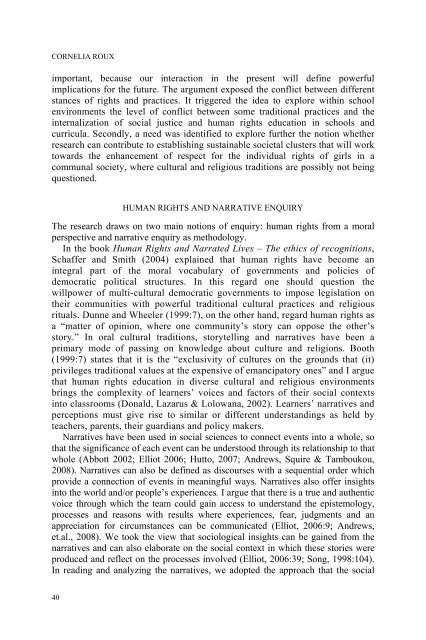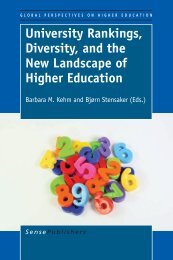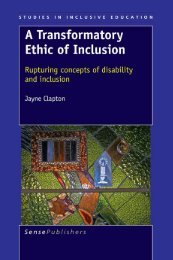Safe Spaces Human Rights Education in Diverse Contexts
Safe Spaces Human Rights Education in Diverse Contexts
Safe Spaces Human Rights Education in Diverse Contexts
Create successful ePaper yourself
Turn your PDF publications into a flip-book with our unique Google optimized e-Paper software.
CORNELIA ROUX<br />
important, because our <strong>in</strong>teraction <strong>in</strong> the present will def<strong>in</strong>e powerful<br />
implications for the future. The argument exposed the conflict between different<br />
stances of rights and practices. It triggered the idea to explore with<strong>in</strong> school<br />
environments the level of conflict between some traditional practices and the<br />
<strong>in</strong>ternalization of social justice and human rights education <strong>in</strong> schools and<br />
curricula. Secondly, a need was identified to explore further the notion whether<br />
research can contribute to establish<strong>in</strong>g susta<strong>in</strong>able societal clusters that will work<br />
towards the enhancement of respect for the <strong>in</strong>dividual rights of girls <strong>in</strong> a<br />
communal society, where cultural and religious traditions are possibly not be<strong>in</strong>g<br />
questioned.<br />
40<br />
HUMAN RIGHTS AND NARRATIVE ENQUIRY<br />
The research draws on two ma<strong>in</strong> notions of enquiry: human rights from a moral<br />
perspective and narrative enquiry as methodology.<br />
In the book <strong>Human</strong> <strong>Rights</strong> and Narrated Lives – The ethics of recognitions,<br />
Schaffer and Smith (2004) expla<strong>in</strong>ed that human rights have become an<br />
<strong>in</strong>tegral part of the moral vocabulary of governments and policies of<br />
democratic political structures. In this regard one should question the<br />
willpower of multi-cultural democratic governments to impose legislation on<br />
their communities with powerful traditional cultural practices and religious<br />
rituals. Dunne and Wheeler (1999:7), on the other hand, regard human rights as<br />
a “matter of op<strong>in</strong>ion, where one community’s story can oppose the other’s<br />
story.” In oral cultural traditions, storytell<strong>in</strong>g and narratives have been a<br />
primary mode of pass<strong>in</strong>g on knowledge about culture and religions. Booth<br />
(1999:7) states that it is the “exclusivity of cultures on the grounds that (it)<br />
privileges traditional values at the expensive of emancipatory ones” and I argue<br />
that human rights education <strong>in</strong> diverse cultural and religious environments<br />
br<strong>in</strong>gs the complexity of learners’ voices and factors of their social contexts<br />
<strong>in</strong>to classrooms (Donald, Lazarus & Lolowana, 2002). Learners’ narratives and<br />
perceptions must give rise to similar or different understand<strong>in</strong>gs as held by<br />
teachers, parents, their guardians and policy makers.<br />
Narratives have been used <strong>in</strong> social sciences to connect events <strong>in</strong>to a whole, so<br />
that the significance of each event can be understood through its relationship to that<br />
whole (Abbott 2002; Elliot 2006; Hutto, 2007; Andrews, Squire & Tamboukou,<br />
2008). Narratives can also be def<strong>in</strong>ed as discourses with a sequential order which<br />
provide a connection of events <strong>in</strong> mean<strong>in</strong>gful ways. Narratives also offer <strong>in</strong>sights<br />
<strong>in</strong>to the world and/or people’s experiences. I argue that there is a true and authentic<br />
voice through which the team could ga<strong>in</strong> access to understand the epistemology,<br />
processes and reasons with results where experiences, fear, judgments and an<br />
appreciation for circumstances can be communicated (Elliot, 2006:9; Andrews,<br />
et.al., 2008). We took the view that sociological <strong>in</strong>sights can be ga<strong>in</strong>ed from the<br />
narratives and can also elaborate on the social context <strong>in</strong> which these stories were<br />
produced and reflect on the processes <strong>in</strong>volved (Elliot, 2006:39; Song, 1998:104).<br />
In read<strong>in</strong>g and analyz<strong>in</strong>g the narratives, we adopted the approach that the social














